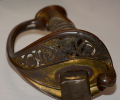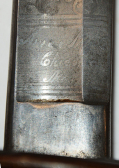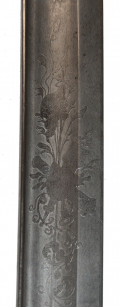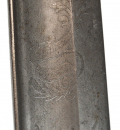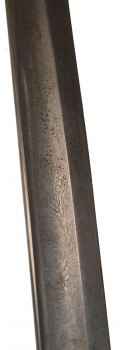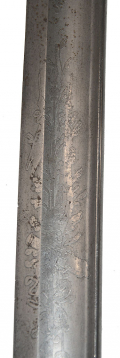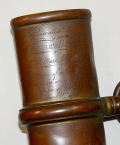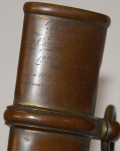site search
online catalog
PRESENTATION AMES MODEL 1850 FOOT OFFICER’S SWORD OF LT. CORNELIUS BATCHELDER, 12th MASS, DATED JUNE 17, 1863, JUST TWO WEEKS BEFORE HE WAS WOUNDED AT GETTYSBURG!

$12,500.00
Quantity Available: 1
Item Code: 1052-1130
Shipping: Determined by Method & Location of buyer
To Order:
Call 717-334-0347,
Fax 717-334-5016, or E-mail
This sword bears a wonderful inscription to a newly commissioned officer from the men of his company, beside whom he had served as a sergeant through Antietam, Fredericksburg and other heavy fighting: Presented to / Lt. CORNELIUS BATCHELDER / 12th Mass Infantry / as a token of esteem from his / comrades in arms the enlisted / men of Co. D / June 17th, 1863. The date is at the beginning of the Gettysburg Campaign, precisely two weeks before the regiment again met the enemy in heavy fighting and suffered significant casualties on July 1 at Gettysburg, with Lt. Batchelder among the wounded, suffering a gunshot wound to the left thigh. After a brief leave to recover, he returned to the company on August 23, 1863, to command it for the rest of their service, which included more heavy combat in Grant’s 1864 Overland Campaign, including Wilderness, Spottsylvania, the North Anna, Cold Harbor and Petersburg, until the regiment headed home on June 25, 1864, for muster out on July 8.
The sword is a very good, uncleaned, regulation U.S. Model sword for foot officers made by Ames, 37” overall with 31-1/2” blade and brass mounted leather scabbard. Although a presentation, it shows good signs of field use, indicating it was not relegated to the officer’s baggage or sent home. The brass hilt and scabbard mounts have a matching, aged patina with traces of gilding showing on the underside and in some of the recesses in the open floral scrollwork of the guard, and a little along the ring bands on the scabbard mounts. The grip is very good, with its full gray sharkskin wrap and twisted brass wire binding, showing only a typical shrinkage gap along the seam on the left side. The quillon finial shows a slight bend forward and the hilt a slight wobble. The scabbard drag is in place, like other scabbard mounts, but similarly shows field use with a small dings and dents.
The blade pad on the underside of the guard is missing. The blade has smooth metal, is muted silver gray in color with some scattered thin darker gray spots, and has visible etching throughout. This includes the etched “Ames Mfg Co / Chicopee / Mass” maker’s address just above the obverse ricasso, followed by a rather straight vine with foliate scrolling branches, enfolding a trophy of arms at top with US shield over a crossed cannon barrel and quiver of arrows, with an American eagle with upraised wings and US shield on its chest, clutching arrows and olive branch and flourishing a foliate ribbon scroll overhead dry needle etched E Pluribus Unum, followed by second panel of foliate scrolling vines. The reverse uses a floral scrolls in the bottom panel and an upper panel with a foliate vine-entwined trophy of arms with cannon barrel and oval shield with pikes and furled flags, along with a simple. “U.S.” between. The scabbard is full length, with mounts in place and complete, the upper mount bearing the inscription on the obverse and the stamped “AMES MFG. COP. / CHICOPEE / MASS” company marking. The leather has good color and is solid, though showing some wrinkles, a couple of deep creases and some cracks to the finish.
Batchelder’s full name was Elias Cornelius Batchelder. He was born March 8, 1832, at Salem, Mass. An 1855 census shows him living there at age 23 with a brother, sister, and their widowed mother, working as a currier - dealing with tanned hides, etc., a profession he seems to have followed for most of his working life. He married in 1857, and the couple had five children, four of whom survived to adulthood, the first being born in 1858. In 1860 he was apparently working in Winchester while his wife stayed with their son with her parents in Essex, helping run her family’s dry goods business.
He enlisted in the army in 1861, joining for duty and enrolling in Company D of the 12th Massachusetts Infantry on May 6, 1861, and mustering in for 3 years as a sergeant on June 26, 1861 (the accepted date of muster-in of the company.) He is listed as present on the all the bi-monthly muster rolls of the company from his enrollment until muster out with the sole exception of a twenty-day leave and apparent granting of a twenty-day extension to recover from his Gettysburg wound, returning to the company on August 23, and thereafter noted as commanding it. The Sept-Oct 1862 roll lists him as 2nd Sergeant, perhaps a result of casualties of Antietam, and the Nov-Dec 1862 roll lists him as promoted 1st Sergeant Dec. 14, 1862, perhaps the result of Fredericksburg. He mustered in as 2nd Lieutenant near Falmouth, Va., on May 9, 1863, one of the cards in his service file reading, “This Officer was discharged as 1st Sergt. By order of Maj. Gen. Reynolds to accept promotion May 9/63, and is mustered as 2nd Lieut. 12th Regt. Mass. Vols vice Whitman promoted Mar. 9th His commission dates from Mar. 9/63, and he has been acting as 2nd Lieut. since date of muster.” Other cards document his command of the company after his return in August 1863 until they mustered out. That he did so as only a 2nd Lieutenant is likely an indication of the heavy casualties they had sustained. He did receive a promotion to 1st Lieutenant in 1864 but, though his commission was dated Feb. 4, 1864, he was not mustered out as 2nd Lieutenant until June 19 and mustered back in as 1st Lieutenant on June 20, less than a week before they left for home. Nevertheless, the records are clear that he was in command of the company.
The 12th Mass was recruited beginning in April 1861 and completed it organization in May at Fort Warren with most of the officers and men mustered in on June 26. They left the state in late July and were posted first to Maryland, guarding fords along the Potomac between Washington and Frederick. They joined Banks in the Shenandoah in early 1862, taking part in his operations there in March and April, and in May became part of McDowell’s 3d Corps Army of Virginia, taking part in the close of the fighting at Cedar Mountain on Aug. 9 and were heavily engaged at 2nd Bull Run as part of the 1st Army Corps, losing 14 killed, 65 wounded, 9 captured and 46 missing by CWData’s numbers and 25 officers and men in killed or mortally wounded alone, including Colonel Fletcher Webster, according to other sources.
They were lightly engaged at South Mountain, but heavily engaged at Antietam as part of Hartsuff’s brigade, fighting in the Miller Cornfield on the Union right, and are listed as the Union regiment suffering the highest percentage of casualties in the battle, losing 224 officers and men out of 334 engaged, including 74 killed or mortally wounded. (They are credited with capturing the colors of the 1s Texas, though there are other claimants, but there is no large disagreement on the price they paid. Some sources list the killed as 49 and the wounded as 165. This does not indicate those who dies of wounds, and totals 214 rather than 224, but still results in casualty rate of more than 64%.) It lost heavily again at Fredericksburg on the Union right, (CWData says 17 killed, 88 wounded and 3 captured or missing,) but were lucky in the Chancellorsville Campaign, suffering slight loss.
The regiment started north on the Gettysburg Campaign on June 12. The sword would certainly have been ordered ahead of time with the date inscribed in anticipation of a formal presentation. We don’t find an account of the presentation. It may have been given to him when it was clear the regiment was about to move, but Cook’s 1882 history of the regiment says they reached Leesburg on June 17 and remained there until June 19, so there may have been opportunity then. At Gettysburg as part of Baxter’s Brigade, Robinson’s Division of Reynolds’s First Corps, they were first posted near the Seminary and then moved to the right of Cutler’s brigade holding Sheads’s Woods, with part of the brigade facing west, part facing north along the Mummasburg Road, and with the 12th Mass at the apex of the line. The exact sequence of movement and deployment is debated, but the brigade shifted its focus more directly to the west and the regiment took part in the repulse of O’Neal’s and then Iverson’s brigades along Oak Ridge, the latter being a particularly bloody, close-range affair. When ammunition ran low later in the fighting they were directed to hold their position with the bayonet, an order commemorated the regimental monument by an empty cartridge box lying next to an empty bayonet scabbard. They were withdrawn on orders of General Robinson with the rest of the division as Confederates flanked the right of the line. They spent July 2 on Cemetery Hill in support of Federal artillery, coming under some artillery fire, and then seeing some skirmish duty on Seminary Ridge in the aftermath of Pickett’s Charge. They seem to have brought some 301 officers and men onto the field and taken 261 into action, losing 15 killed, 52 wounded and 62 captured or missing, almost all in the first day’s fighting.
Batchelder is clear that he was wounded in the first day’s fighting. There is no record of capture and parole in his service record so he seems to have been able to make it to an aide station and hospital somewhere in the rear and was evacuated at some point to Baltimore where the Medical Director gave him a twenty-day leave to recover, dating from July 13. An August 1 letter asking another twenty days for him from a US Army Surgeon and Medical Director in Boston seems to have been granted, explaining his return to the company later that month, where he assumed command on August 23.
Batchelder is then listed as present on the company muster rolls to the final muster out of the regiment in July 1864, placing him and the sword in further heavy fighting. During that time the regiment took part in the Bristoe Campaign in October 1863, the advance to the Rappahannock in November, and the Mine Run Campaign in late November/early December. In 1864, as part of the 5th Corps, they fought at the Wilderness (on the Orange Turnpike on May 5 and the Plank Road on May 6,) at Laurel Hill, and Spottsylvania- including the Alsop, Jones and Spindle farms and the May 12 assault on the salient- fighting on the North Anna, at Jericho Ford, line of the Pamunkey in late May, and Totopotomoy at the end of the month. They were at Cold Harbor from June 1 to June 12, including Bethesda Church and White Oak Swamp, followed by service in front of Petersburg from June 16 to June 18, followed by their return north on June 25 to muster out on July 8. Dyer’s Compendium attributes the loss of 18 officers and 175 enlisted men in killed and mortally wounded alone.
After the war Batchelder returned to Massachusetts and continued work as currier according the the 1870 and 1880 census. He moved to Florida sometime shortly after, where he is picked up as a merchant in 1885, but the family returned to Massachusetts prior to his wife’s death there in 1889. He passed away there in September 1899. [sr] [ph:L]
~~~~~~~~~~~~~~~~~~~~~~~~~~~~~~~~~~~
THIS ITEM, AS WITH ALL OTHER ITEMS AVAILABLE ON OUR WEB SITE,
MAY BE PURCHASED THROUGH OUR LAYAWAY PROGRAM.
CLICK HERE FOR OUR POLICIES AND TERMS.
THANK YOU!
Inquire About PRESENTATION AMES MODEL 1850 FOOT OFFICER’S SWORD OF LT. CORNELIUS BATCHELDER, 12th MASS, DATED JUNE 17, 1863, JUST TWO WEEKS BEFORE HE WAS WOUNDED AT GETTYSBURG!
For inquiries, please email us at [email protected]
Most Popular
Historical Firearms Stolen From The National Civil War Museum In Harrisburg, Pa »
Theft From Gravesite Of Gen. John Reynolds »
Selection Of Unframed Prints By Don Troiani »
Fine Condition Brass Infantry Bugle Insignia »
British Imported, Confederate Used Bayonet »
Scarce New Model 1865 Sharps Still In Percussion Near Factory New »
featured item
CONFEDERATE CAVALRY CAPTAIN’S FROCK COAT OF CAPT. EDWARD BIRD, “EFFINGHAM HUSSARS,” 2nd BATTALION AND 5th REGIMENT GEORGIA CAVALRY
This rare, identified, Confederate cavalry captain’s frock coat belonged to an officer who served from 1861 though 1865, rising from Captain to Colonel, with extensive action especially in Wheeler’s cavalry corps fighting against Sherman in the… (1179-232). Learn More »
site search
Upcoming Events
May 16 - 18: N-SSA Spring Nationals, Fort Shenandoah, Winchester, VA Learn More »






